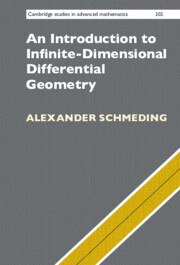Book contents
- Frontmatter
- Contents
- Preface
- 1 Calculus in Locally Convex Spaces
- 2 Spaces and Manifolds of Smooth Maps
- 3 Lifting Geometry to Mapping Spaces I: Lie Groups
- 4 Lifting Geometry to Mapping Spaces II: (Weak) Riemannian Metrics
- 5 Weak Riemannian Metrics with Applications in Shape Analysis
- 6 Connecting Finite-Dimensional, Infinite-Dimensional and Higher Geometry
- 7 Euler–Arnold Theory: PDEs via Geometry
- 8 The Geometry of Rough Paths
- Appendix A A Primer on Topological Vector Spaces and Locally Convex Spaces
- Appendix B Basic Ideas from Topology
- Appendix C Canonical Manifold of Mappings
- Appendix D Vector Fields and Their Lie Bracket
- Appendix E Differential Forms on Infinite-Dimensional Manifolds
- Appendix F Solutions to Selected Exercises
- References
- Index
6 - Connecting Finite-Dimensional, Infinite-Dimensional and Higher Geometry
Published online by Cambridge University Press: 08 December 2022
- Frontmatter
- Contents
- Preface
- 1 Calculus in Locally Convex Spaces
- 2 Spaces and Manifolds of Smooth Maps
- 3 Lifting Geometry to Mapping Spaces I: Lie Groups
- 4 Lifting Geometry to Mapping Spaces II: (Weak) Riemannian Metrics
- 5 Weak Riemannian Metrics with Applications in Shape Analysis
- 6 Connecting Finite-Dimensional, Infinite-Dimensional and Higher Geometry
- 7 Euler–Arnold Theory: PDEs via Geometry
- 8 The Geometry of Rough Paths
- Appendix A A Primer on Topological Vector Spaces and Locally Convex Spaces
- Appendix B Basic Ideas from Topology
- Appendix C Canonical Manifold of Mappings
- Appendix D Vector Fields and Their Lie Bracket
- Appendix E Differential Forms on Infinite-Dimensional Manifolds
- Appendix F Solutions to Selected Exercises
- References
- Index
Summary
In this chapter, we will highlight the interesting connection between finite and infinite dimensional differential geometry. To this end, we shall consider Lie groupoids, which can be understood as elements from higher geometry. The moniker higher geometry stems from the fact that in the language of category theory, these objects form higher categories. Previously we discussed how finite-dimensional manifolds and geometric structures give rise to infinite-dimensional structures such as Lie groups (e.g. the diffeomorphims and groups of gauge transformations) and Riemannian metrics (such as the L^2-metric from shape analysis). While a manifold determines an (in general infinite-dimensional) group of diffeomorphisms, we turn this observation now on its head and investigate whether the underlying finite-dimensional geometric structure is recognisable from its associated infinite dimensional object.
- Type
- Chapter
- Information
- An Introduction to Infinite-Dimensional Differential Geometry , pp. 120 - 137Publisher: Cambridge University PressPrint publication year: 2022
- Creative Commons
- This content is Open Access and distributed under the terms of the Creative Commons Attribution licence CC-BY-NC-ND 4.0 https://creativecommons.org/cclicenses/

